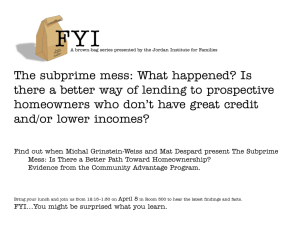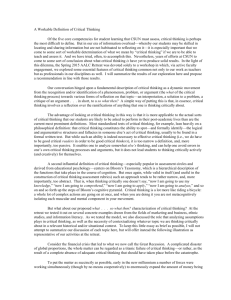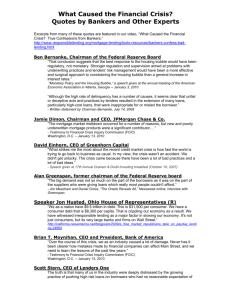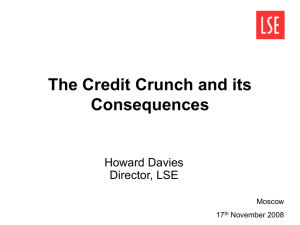NeighborhoodInfo DC Fact Sheet
advertisement
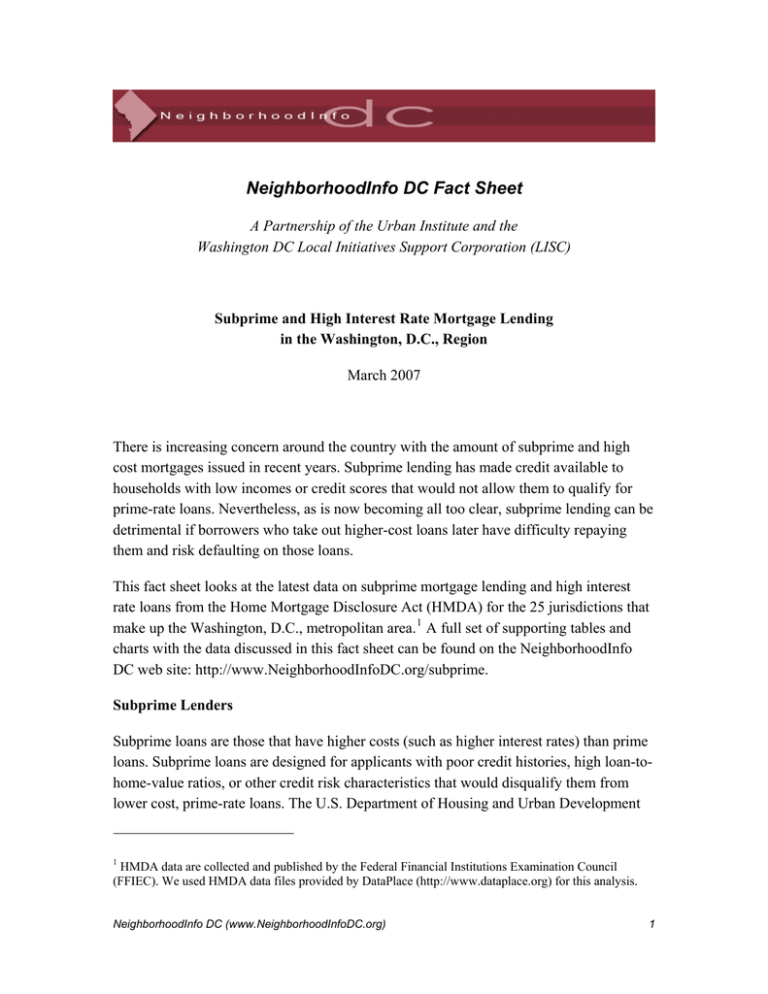
NeighborhoodInfo DC Fact Sheet A Partnership of the Urban Institute and the Washington DC Local Initiatives Support Corporation (LISC) Subprime and High Interest Rate Mortgage Lending in the Washington, D.C., Region March 2007 There is increasing concern around the country with the amount of subprime and high cost mortgages issued in recent years. Subprime lending has made credit available to households with low incomes or credit scores that would not allow them to qualify for prime-rate loans. Nevertheless, as is now becoming all too clear, subprime lending can be detrimental if borrowers who take out higher-cost loans later have difficulty repaying them and risk defaulting on those loans. This fact sheet looks at the latest data on subprime mortgage lending and high interest rate loans from the Home Mortgage Disclosure Act (HMDA) for the 25 jurisdictions that make up the Washington, D.C., metropolitan area. 1 A full set of supporting tables and charts with the data discussed in this fact sheet can be found on the NeighborhoodInfo DC web site: http://www.NeighborhoodInfoDC.org/subprime. Subprime Lenders Subprime loans are those that have higher costs (such as higher interest rates) than prime loans. Subprime loans are designed for applicants with poor credit histories, high loan-tohome-value ratios, or other credit risk characteristics that would disqualify them from lower cost, prime-rate loans. The U.S. Department of Housing and Urban Development 1 HMDA data are collected and published by the Federal Financial Institutions Examination Council (FFIEC). We used HMDA data files provided by DataPlace (http://www.dataplace.org) for this analysis. NeighborhoodInfo DC (www.NeighborhoodInfoDC.org) 1 (HUD) classifies mortgage lenders as specialists if such subprime loans account for at least half of their conventional (i.e., not government-backed or insured) business. HUD also uses feedback from lenders, policy analysts, and housing advocacy groups to update the list of subprime lenders (Pettit and Droesch 2005, 8). By matching HUD’s subprime lender list to HMDA loan records, we can track lending by subprime specialists from 1997 to 2005. High Interest Rate Loans In 2004, HMDA began collecting information on the interest rate for individual mortgages, allowing the identification of high interest rate loans. High interest rate loans have annual percentage interest rates exceeding the comparable U.S. Treasury yield by 3 percentage points or more, for first liens, and by 5 points or more, for second liens. While trends in high interest rate loans cannot be compared as far back as loans from subprime lenders, these loans do include costly mortgages issued by lenders other than those in HUD’s subprime specialist list. 2 They therefore help give a more complete picture of the subprime lending market than the subprime lender data alone. In this fact sheet, we present data on high interest rate loans for 2005. Current Conditions and Trends Analysis of the HMDA data by NeighborhoodInfo DC shows the following: • Subprime lending reached a new high in the region in 2005. The percentage of new conventional home purchase and refinance mortgages issued by subprime lenders was 17.6 percent in the Washington, D.C., region in 2005. This was an increase from 15.1 percent in 2004 and more than three times the share of subprime loans in 2001 (5.5 percent). • One-quarter of mortgage loans had high interest rates in 2005. One out of every four (25.1 percent) home-purchase and refinance mortgage loans issued in the Washington, D.C., region in 2005 had high interest rates. The region’s share 2 Since high interest rate loan data are relatively new for HMDA and are subject to reporting inconsistencies, comparisons between 2004 and 2005 may be misleading. The FFIEC also cautions that changes in the interest rate environment—specifically, in the relationship between short-term and long-term interest rates—as well as changes in lenders’ business practices and in consumers’ borrowing practices or credit risk profiles can affect comparisons of the loan cost data (FFIEC 2006). Therefore, we chose not to compare 2004 and 2005 data on high interest rate loans in this fact sheet. NeighborhoodInfo DC (www.NeighborhoodInfoDC.org) 2 of high interest rate loans was 7.5 percentage points higher than the share of loans from subprime lenders. This was also true within the individual jurisdictions, indicating that the subprime lending rates most likely underestimate the proliferation of high-cost mortgage loans. • The highest rates of subprime lending and high interest rate loans were in Prince George’s County, Maryland, and several of the further Maryland and Virginia suburban jurisdictions. One out of every three (33.0 percent) homepurchase and refinance loans in Prince George’s County was issued by subprime lenders in 2005 (figure 1), and 44.0 percent were high interest rate loans, the highest rates among all jurisdictions in the region (figure 2). The share of subprime lending in the county has been steadily increasing since 2001, when 14.2 percent of loans were issued by subprime lenders. The next highest shares of high cost loans were in Manassas Park city, Virginia, with 25.3 percent of loans from subprime lenders and 36.9 percent high interest rate loans in 2005; Charles County, Maryland, with 24.5 percent of loans from subprime lenders and 33.6 percent high interest rate loans; and Manassas city, Virginia, with 23.0 percent of loans from subprime lenders and 35.5 percent high interest rate loans. • Although not among the areas with the highest use of subprime loans, the shares of loans from subprime lenders in Montgomery County, the District of Columbia, Fairfax County, and Fairfax city have increased sharply since the beginning of the decade. The share of home purchase and refinance loans from subprime lenders increased to 15.6 percent in Montgomery County, Maryland, in 2005, up from 12.7 percent in 2004 and a recent low of 4.1 percent in 2001. In the District of Columbia, shares of loans from subprime lenders shot up from 8.0 percent in 2004 to 12.5 percent in 2005, a dramatic increase from a low of 3.2 percent in 2002. Fairfax County and Fairfax city experienced similar increases. The share of loans from subprime lenders in Fairfax city, Virginia, grew from 3.7 percent in 2001 and 2002 to 12.0 percent in 2005. In Fairfax County, Virginia, the rates increased from 3.7 percent in 2001 to 11.1 percent in 2005. • The lowest rates of subprime lending and high interest rate loans were in Falls Church city, Arlington County, and Alexandria city. Each of these Virginia jurisdictions had less than 7 percent of home purchase and refinance mortgages issued by subprime lenders in 2005. The shares were 6.3 percent in Alexandria city, Virginia, 5.5 percent in Arlington County, Virginia, and 5.3 percent in Falls Church city, Virginia. These all represent slight increases in NeighborhoodInfo DC (www.NeighborhoodInfoDC.org) 3 subprime lending levels from earlier in the decade. Shares of high interest rate loans were 10 percent or lower in these three jurisdictions in 2005. A complete set of HMDA data profiles on subprime lending and high interest rate loans is available at http://www.NeighborhoodInfoDC.org/subprime. In addition to the information described in this fact sheet, the supporting data profiles list the top 10 subprime and high interest rate loan lenders for each jurisdiction in the region in 2005. W References Federal Financial Institutions Examination Council. 2006. “Press Release, September 08, 2006.” http://www.ffiec.gov/hmcrpr/hm090806.htm. Pettit, Kathryn, and Audrey Droesch. 2005. A Guide to Home Mortgage Disclosure Act Data. Washington, DC: DataPlace. W For further information, contact NeighborhoodInfo DC by e-mail at info@neighborhoodinfodc.org. NeighborhoodInfo DC (www.NeighborhoodInfoDC.org) 4 Subprime and High Interest Rate Mortgage Lending, Washington, D.C., Region Fig. 1 - Percent of New Conventional Home Purchase and Refinance Mortgages by Subprime Lenders, 2005 Prince George's County, MD Manassas Park city, VA Charles County, MD Manassas city, VA Prince William County, VA Calvert County, MD Frederick County, MD Spotsylvania County, VA Warren County, VA Culpeper County, VA Stafford County, VA Montgomery County, MD King George County, VA Fauquier County, VA District of Columbia Berkeley County, WV Clarke County, VA Fairfax city, VA Fairfax County, VA Jefferson County, WV Loudoun County, VA Fredericksburg city, VA Alexandria city, VA Arlington County, VA Falls Church city, VA 33.0 25.3 24.5 23.0 18.4 17.9 17.0 16.9 16.7 16.3 16.3 15.6 14.3 12.6 12.5 12.3 12.1 12.0 11.1 9.7 9.5 9.2 6.3 5.5 5.3 0 10 20 30 40 50 Fig. 2 - Percent of New Conventional Home Purchase and Refinance Mortgages with High Interest Rates, 2005 Prince George's County, MD Manassas Park city, VA Manassas city, VA Charles County, MD Culpeper County, VA Prince William County, VA Spotsylvania County, VA Berkeley County, WV Warren County, VA Calvert County, MD Frederick County, MD Stafford County, VA King George County, VA Montgomery County, MD Fredericksburg city, VA District of Columbia Jefferson County, WV Fauquier County, VA Fairfax city, VA Fairfax County, VA Loudoun County, VA Clarke County, VA Alexandria city, VA Arlington County, VA Falls Church city, VA 44.0 36.9 35.5 33.6 28.0 27.4 26.2 24.4 23.8 23.5 23.3 22.8 22.6 21.4 21.3 20.2 18.3 17.6 17.0 15.9 15.5 15.3 10.0 8.5 8.0 0 10 NeighborhoodInfo DC (www.NeighborhoodInfoDC.org) 20 30 40 50 5
